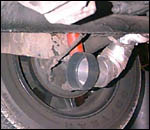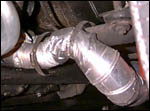
06 May Keeping Your Cool
 Will bigger engines run hotter? While the waste heat that an engine produces can be affected by many factors – including the parts used, compression ratio, head design, quality of assembly, use, etc – generally speaking, larger engines that produce more horsepower will run hotter. Some have argued that, with an increase in the horsepower that an engine produces, no upgrades to the engine’s cooling system are needed. While modest changes in an engines output should not require any changes to the cooling system, if you are planning on building that traditional 2 liter, dual-carbed, fire-breathing engine for your Cal Looker, it would be wise to address the increased cooling needs of the engine.
Will bigger engines run hotter? While the waste heat that an engine produces can be affected by many factors – including the parts used, compression ratio, head design, quality of assembly, use, etc – generally speaking, larger engines that produce more horsepower will run hotter. Some have argued that, with an increase in the horsepower that an engine produces, no upgrades to the engine’s cooling system are needed. While modest changes in an engines output should not require any changes to the cooling system, if you are planning on building that traditional 2 liter, dual-carbed, fire-breathing engine for your Cal Looker, it would be wise to address the increased cooling needs of the engine.
A commonly heard argument is that, since an engine only requires “x” horsepower to go “y” speed, it’s cooling requirements are no different traveling at that speed whether you have a 50 hp stock engine, or a 150 hp two liter engine. Such a statement fails to take into account numerous factors, including:
* Larger cylinder diameter, and conversely less total cylinder fin surface area for cooling.
* Longer stroke cranks and/or different rod lengths, which increase the average piston speed.
* The air requirements of dual carburetors, which can rob air from the cooling fan (those 48’s have a huge appetite for air!).
It is also interesting to note that, as the displacement and horsepower of the humble VW engine increased over time, so did the cooling system (larger oil cooler, larger fan, improved fan shroud and cylinder tin design, etc). Clearly, the engineers at VW and Porsche felt that increased cooling abilities should go hand-in-hand with increased output with their aircooled engines.
I have a very simple and inexpensive method of bringing additional air into the engine compartment. When my two liter was in my convertible, in addition to the dog house cooler, I ran a Messa 96 plate cooler with thermostat-activated 10″ fan. I needed this set-up because convertibles run hotter than sedans due to the lack of louvers below the rear window, and the disrupted air flow over the car (roof down). I also towed my small boat with it which increased the demands on the engine’s cooling system.
 When I placed this motor in my ’67, however, I got rid of the Messa cooler and the extra lines, feeling that they were no longer needed. I did discover, however, that on hot days (high ’80s (F) and above, while on the highway, with a fully-loaded car), my Berg dipstick sensor would flicker the oil light (approximately 225 degrees F). It seemed to me that the fan needed a steady stream of cool, near-ambient air. I therefore cut out a 2″ hole in the front breast plate, to the right of the starter. I installed a 2″ hose aimed at the fan, running through the hole, down towards the right lower shock tower (see photo #1 this page, taken from the left side of the car, looking to the right rear). I have a 4″ scoop clamped to the shock tower (on the inside next to the bottom of the shock – see photo #2 next page, taken from the right rear looking forward). I ran an adapter from the 4″ scoop down to the 2″ hose, which also acts as a great velocity stack. I have found this set-up to be extremely effective, even on long road trips with a fully-loaded car in 100 degree heat. In fact, this set-up is so effective that I have to plug the scoop in the Fall to ensure that the engine doesn’t run too cool.
When I placed this motor in my ’67, however, I got rid of the Messa cooler and the extra lines, feeling that they were no longer needed. I did discover, however, that on hot days (high ’80s (F) and above, while on the highway, with a fully-loaded car), my Berg dipstick sensor would flicker the oil light (approximately 225 degrees F). It seemed to me that the fan needed a steady stream of cool, near-ambient air. I therefore cut out a 2″ hole in the front breast plate, to the right of the starter. I installed a 2″ hose aimed at the fan, running through the hole, down towards the right lower shock tower (see photo #1 this page, taken from the left side of the car, looking to the right rear). I have a 4″ scoop clamped to the shock tower (on the inside next to the bottom of the shock – see photo #2 next page, taken from the right rear looking forward). I ran an adapter from the 4″ scoop down to the 2″ hose, which also acts as a great velocity stack. I have found this set-up to be extremely effective, even on long road trips with a fully-loaded car in 100 degree heat. In fact, this set-up is so effective that I have to plug the scoop in the Fall to ensure that the engine doesn’t run too cool.
One thing to note is that with this system it that it is important to mount a screen (not pictured) over the mouth of the scoop, in order to keep debris out of the fan. If you are not running air filters, then a very fine mesh screen is recommended over the scoop in order to keep dirt out of the combustion chamber.
While I recognize that bigger, higher compression ratio motors produce more waste heat, and may require additional oil coolers, cooling the oil is an after-the-fact solution. Providing cool air to the fan keeps the head temperatures reasonable, and the oil never gets excessively hot to begin with. The drawback to my system, however, is that it relies on the car’s moving to bring air in. It will therefore not help with cars that tend to heat-up in traffic.
Aside from ensuring that the engine combination works (parts, assembly, jetting, timing, octane, c/r, etc.), keeping an engine cool is all in the details. I bare-metal all the original VW tin, and paint it with two thin coats of semi-gloss black. I also paint the cylinders and push rod tubes with a thin coat of diluted flat black to help with cooling. No gaps in the tin, mounting the filter in the fender in a stream of cool air, etc. It all adds up.

